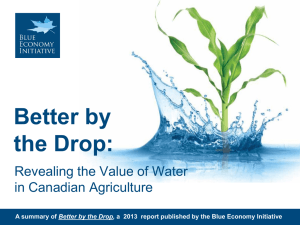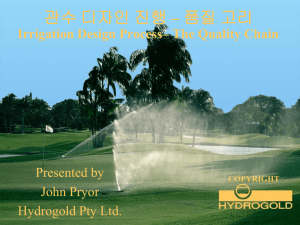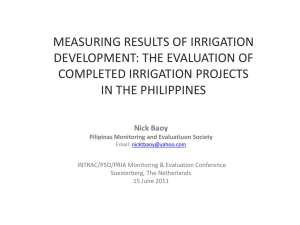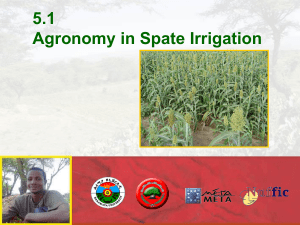Power Point - Idaho Irrigation Equipment Association
advertisement
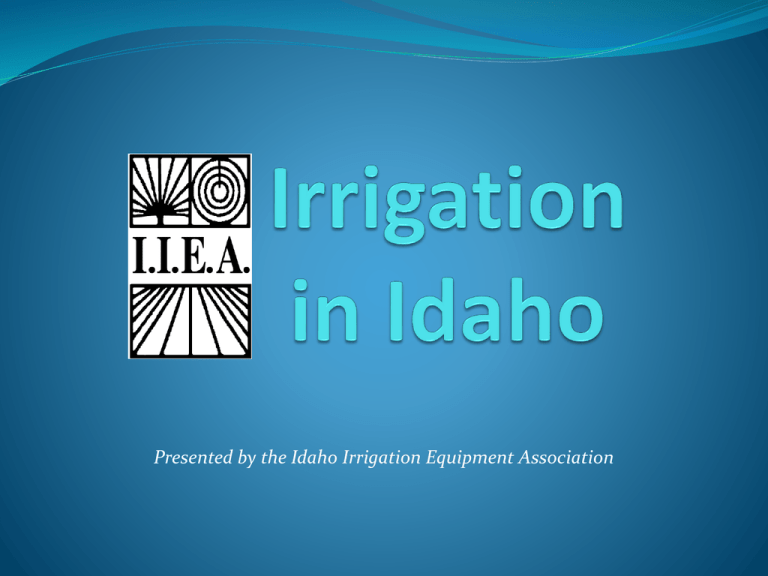
Presented by the Idaho Irrigation Equipment Association To control snow and water run-off and manage water resources in Idaho, many dams, canals, and ditches have been built. These man-made structures have enabled the water to be diverted to water crops, parks, and landscaping. Lucky Peak Dam in Western Idaho diverts water to the canals. Irrigation is the controlled application of water for agricultural and landscape purposes through manmade systems. Because of Idaho’s climate, farmers can’t count on regular rainfall to water plants. So they use irrigation to water their plants which results in producing some of the best landscapes, crops and seed in the world. 5 2 1 4 3 The 2008 Farm and Ranch Irrigation Survey reported that United States farmers and ranchers irrigated 54.9 million acres of farmland that year. In 2007, Idaho had almost 3.3 million acres of irrigated land. The states with the largest area of irrigated lands are: 1) Nebraska 2) California 3) Texas 4) Arkansas and 5) Idaho. This slide show will discuss six kinds of irrigation: landscaping- including home, parks and commercial- flood, siphon tube, wheel line, drip line and center pivot. Landscape Irrigation Sprinklers are a vital part of landscaping for homes, parks, golf courses and businesses. Instead of growing food, desired crops are flowers, trees, and grass. A good sprinkler system helps conserve water and produces beautiful landscapes and scenery. Flood Irrigation Flood irrigation is water that is pumped or brought to the fields and is allowed to flow along the ground among the crops or fields. This method is simple and cheap, and is widely used by societies in less developed parts of the world as well as in the United States. Farmers can capture the runoff in ponds and pump it back up to the front of the field where it is reused for the next cycle of irrigation. Siphon Tubes Siphon tubes are a basic implement used in irrigation to transfer water over a barrier (such as the bank of a raised irrigation canal), using the siphon principle. At the simplest, they consist of a pipe with no working parts. To work they rely on the water level in the canal being at a higher level than the water level in the field being irrigated. Like any siphon they must be primed (that is, filled with water) before they will start reliably transferring water. Once primed and positioned correctly, they will continue transferring water from the source to the destination. Wheel Lines Wheel Lines come in 40-foot sections and can be assembled into whatever length a farmer needs to cover. They are normally propelled by a motor/mover in the middle of the line that rolls the wheel line across the field, usually 50 feet to 60 feet per move. Crops are limited because of the short height of the pipe. Drip Irrigation For irrigating fruits and vegetables this method is much more efficient than flood irrigation. Water is sent through plastic tubes (with holes in them) that are either laid along the rows of crops or even buried along their rootlines. Evaporation is cut way down, and 40 percent of the water used is saved, as compared to flood irrigation. The above photo shows a field being irrigated by drip irrigation. The right side of the picture is after 24 hours and the left side is after 12 hours. Center Pivots The center-pivot systems have a number of metal frames (on rolling wheels) that hold the water tube out into the fields. There can be a very big water gun at the end of the tube. Electric motors move each frame in a big circle around the field (the tube is fixed at the water source at the center of the circle), squirting water.




